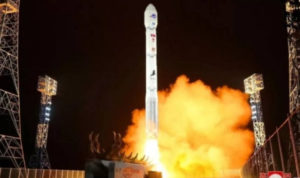South Korea’s Quest for Space Dominance
In a bold move to bolster its defense capabilities against the nuclear threat posed by North Korea, South Korea launched its second domestically engineered military surveillance satellite on Sunday (local time) in the United States.
This eagerly anticipated announcement follows hot on the heels of the triumphant launch of South Korea’s inaugural military satellite, propelled into orbit by the renowned SpaceX Falcon 9 rocket, helmed by the visionary Elon Musk.
This groundbreaking development signals an escalation in the high-stakes space rivalry gripping the Korean peninsula, particularly in the wake of North Korea’s recent launch of its own military reconnaissance satellite.
This momentous launch of Seoul’s highly anticipated second spy satellite, ascended into the heavens from the iconic John F. Kennedy Space Center in Florida, riding atop the legendary SpaceX Falcon 9 rocket.
South Korea’s Satellite Surge and North Korea’s Space Bravado
The initial first satellite launched last year successfully entered orbit, carrying an electro-optical and infrared sensor capable of capturing detailed images of Earth’s surface. High-resolution images of central Pyongyang have already been transmitted, with full mission operations anticipated to commence as soon as June.
But the ambitions of Seoul did not stop there as it unveiled plans to deploy a staggering total of five cutting-edge military spy satellites by the year 2025, solidifying its position as a global leader in space-based reconnaissance.

Once all five of South Korea’s formidable spy satellites take their positions in orbit and initiate their mission, the South Korean military will wield an unprecedented level of surveillance prowess, capable of continuously monitoring vital facilities within North Korea with imagery updates streaming in every two hours, as revealed in a report by Seoul’s esteemed government-operated broadcaster, KTV.
Meanwhile, North Korea has brazenly asserted its own advancements in the space race, boasting of its orbiting spy satellite’s transmission of images depicting a US naval stronghold at Pearl Harbor in Hawaii and other strategically significant targets scattered across South Korea.
The North’s triumphant launch of the “Malligyong-1” marked a watershed moment, overcoming previous setbacks with aplomb, having weathered two failed attempts in May and August of the preceding year.
Seoul has not hesitated to point fingers, alleging that North Korea received technical support from Moscow for this pivotal launch, purportedly in exchange for supplying weaponry to fuel Russia’s military engagements, notably the conflict in Ukraine. Such geopolitical maneuvers further stoke tensions and raise the stakes in the intricate web of global power dynamics.

The strategic deployment of a functional reconnaissance satellite into orbit marks a significant leap forward for North Korea’s intelligence-gathering apparatus, amplifying its capacity to surveil its southern neighbor with unprecedented precision. Experts unanimously agree that such technological advancements could potentially tip the scales in any future military confrontation, furnishing Pyongyang with invaluable real-time data crucial for strategic decision-making.
In a series of ominous declarations, Pyongyang has resolutely designated South Korea as its “principal enemy,” signaling a dramatic escalation in tensions. This hostile stance has been further underscored by the dismantling of agencies dedicated to fostering reunification and diplomatic outreach, replaced instead by saber-rattling rhetoric and veiled threats of war over even the slightest territorial encroachment, no matter how minuscule. The geopolitical landscape teeters on the brink of volatility as North Korea’s bellicose posturing raises the specter of conflict in the region.










